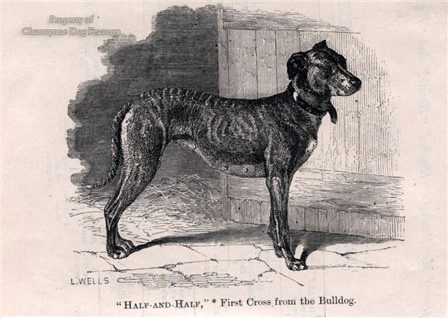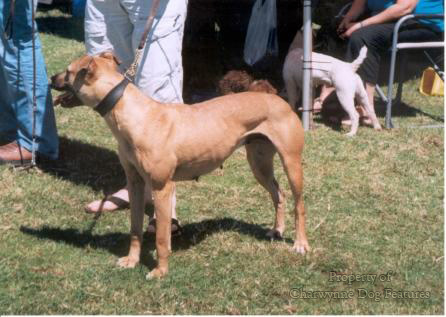563 Bull Lurchers
REBIRTHING THE BULL_LURCHER
by David Hancock
 "...a breed of deerhounds were long preserved at Godmersham and Eastwell in Kent, the strain of which went back to Elizabethan days. A good one always pinned the deer by the ear, a criterion of the purity of the strain. They were cream or fawn-coloured, with dusky muzzles, greyhound speed and half-greyhound, half-mastiff-like heads...resembling boarhounds in Snyder's or Velasquez's pictures."
"...a breed of deerhounds were long preserved at Godmersham and Eastwell in Kent, the strain of which went back to Elizabethan days. A good one always pinned the deer by the ear, a criterion of the purity of the strain. They were cream or fawn-coloured, with dusky muzzles, greyhound speed and half-greyhound, half-mastiff-like heads...resembling boarhounds in Snyder's or Velasquez's pictures."
Those words from Lord Ribblesdale's 'The Queen's Hounds' described what might be termed heavy hounds or hunting mastiffs. Today some of the Bull Lurchers being bred closely resemble these dogs. In 'Bridleways Through History' Lady Apsley wrote that: "Charles IX received a present of some 'great hounds' from Queen Elizabeth, referred to as 'mastiffs' or 'dogues'...used in France for killing wolves after the levriers d'attache les avaient coiffes' (i.e. after the sighthounds got them by the ear).
In Old English the word docga referred to a mastiff-like dog and has survived as dogue (French), Dogo (Argentine-Spanish), dogge (German) and dogg (Swedish). The Deutsche Dogge is the Great Dane; the Englische Dogge was famed as a hunting mastiff in medieval Europe. The Saxon word bandogge, used in Middle English, referred to a leashed hunting mastiff, not a tied-up yard-dog. The word mastiff, now mainly used to describe the breed of Mastiff in England, was not in common use until the early 18th century. It was used loosely to describe any huge dog, not a distinct breed-type. The word mastiff is now agreed to derive from an original source meaning of mixed breeding.
Inevitably the loss of function once the hunting of big game with hounds lapsed led to the disappearance of many types of heavy hound: the Bullenbeisser in Germany, the Mendelan in Russia and the Suliot Dog in Macedonia/Greece, for example. The huge staghounds of Devon and Somerset, disbanded early in the last century, were twenty seven inches (0.68m) high and described by Dr. Charles Palk Collyns in his 'The Chase of the Wild Red Deer' as "A nobler pack of hounds no man ever saw. They had been in the country for years, and had been bred with the utmost care for the express purpose of stag-hunting...their great size enabled them to cross the long heather and rough sedgy pasturage of the forest without effort or difficulty."
In his valuable book 'Hunting and Hunting Reserves in Medieval Scotland', John Gilbert writes of references to mastiffs in the Scottish Forest Laws; capable of attacking and pulling down deer, they wore spiked collars and were used to attack wolves and hunt boar, when they hunted to the horn. Gilbert was referring to a heavy hound not what is now the modern breed of Mastiff, whose appearance and especially its movement is scarcely houndlike. This makes a point for me. Directly you stop breeding a dog to a known function, even one long lapsed, then the breed that dog belongs to loses its way. We saw this in the Bulldog and now see it increasingly in the broad-mouthed dogs, worryingly too short in the muzzle and progressively less athletic. Their fanciers forget the sporting origins of their breed, foolishly to my mind, and pursue obsessions with heads, bone and bulk. This is not only historically incorrect but never to the benefit of the dog.
The mastiff breeds, whether huge like the Mastiff of England, as small as the Bulldog of Britain, cropped-eared like the Cane Corso of Italy and the Perro de Presa of the Canaries, loose-skinned like the Mastini of Italy or dock-tailed like the Boerboel of South Africa, are not only fine examples of powerful but good-tempered dogs but form part of their respective nation's canine heritage. It is vital that they do not fall victim to show ring faddists or misguided cliques of rosette-chasing, over-competitive zealots. Today's breeders need to wake up to such unacceptable excesses, honour the proud heritage of these distinguished breeds and respect them for what they are: the light heavyweights of the canine world, quick on their feet and devastating at close quarter protection when threatened. Such magnificent canine athletes deserve the very best custodianship, with every fancier respecting their hound ancestry, remembering their bravery at man's behest and revering their renowned stoicism.
Whatever the blend of blood behind a Bull Lurcher, the anatomical requirements are similar for this type of hunting dog: a powerful neck, a seizing jaw, with breadth right down to the nose, strong loins, good spring of rib, with the rib-cage showing good length as well as circumference, immense power in the sprint and great muscularity. Mentally, such a dog has to have considerable persistence, immense determination when closing with quarry yet always be responsive to commands. In the wrong hands such a dog is capable of being misused or not being satisfactorily under control. In today's society, a powerful hunting dog, allowed to be too dominant or inadequately trained, is going to be troublesome. The awesome catch-dogs depicted by Snyder and Desportes simply cannot fit in with 21st century living in Britain. Breeders of Bull Lurchers need to be wise and socially aware, concentrating on highly biddable dogs and avoiding the production of hyper-aggressive specimens. The Bull Lurcher perpetuates a long line in powerful hunting dogs; their breeders need to respect this as well as the constraints of modern living.
